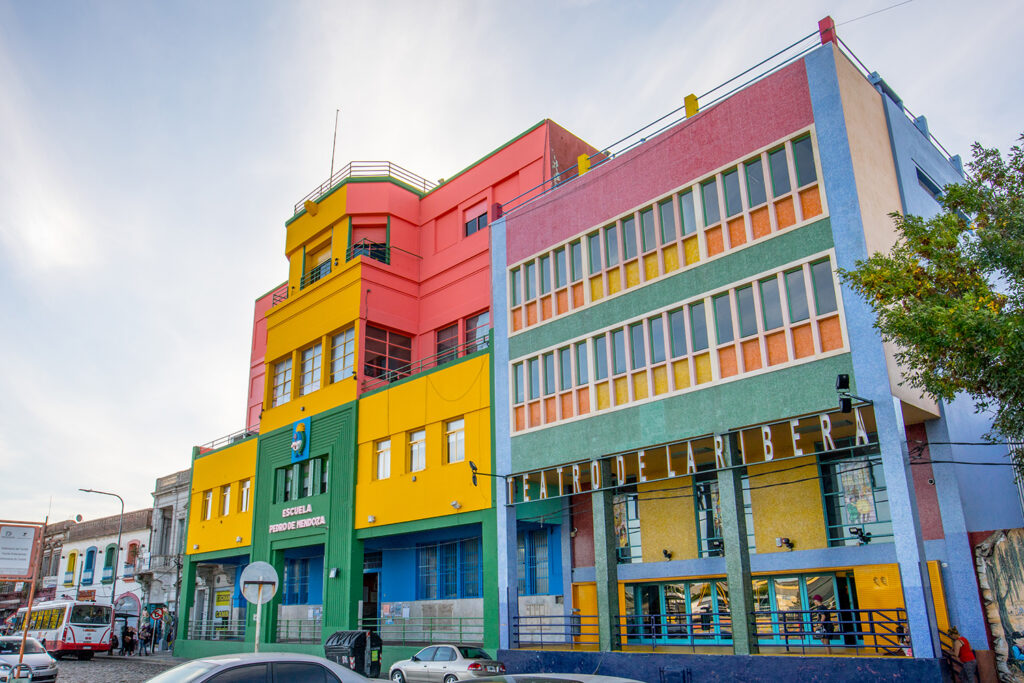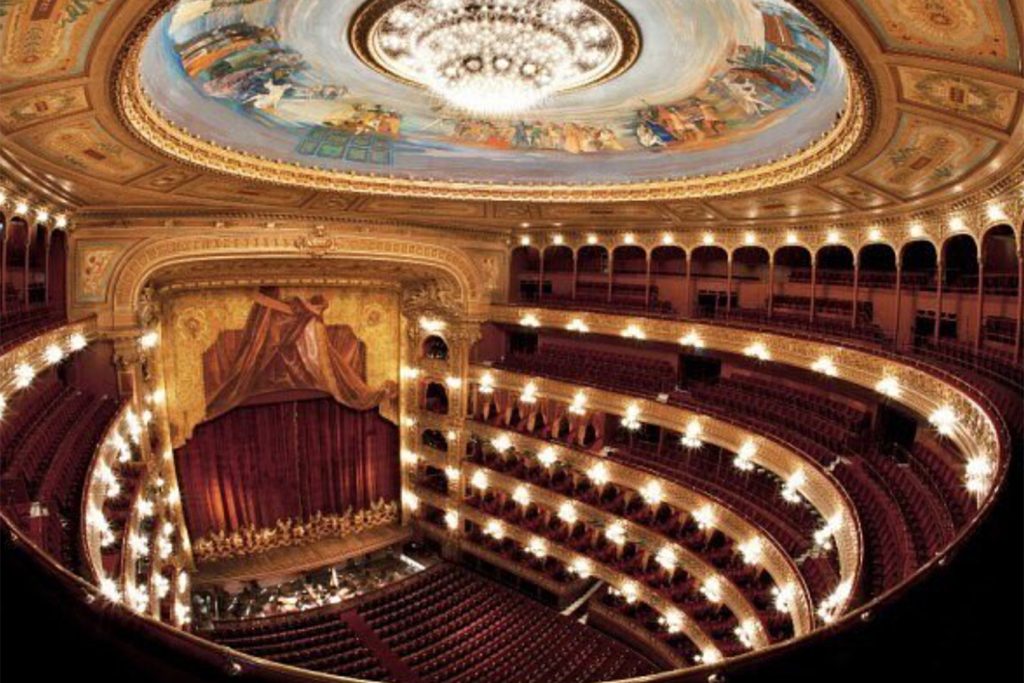Top 10 Must-See Attractions in Buenos Aires
In this article we highlight the most popular and iconic sights in Argentina’s capital city, from the colorful residences of La Boca district to the historic Plaza de Mayo.
Ateneo Bookstore
According to British newspaper The Guardian, El Ateneo Grand Splendid is the second nicest bookstore in the world.
Located in the Recoleta neighborhood, El Grand Spendid theatre opened in 1919 and immediately became a beacon of Porteño culture, hosting ballet, opera, and the first “talkies” shown in Buenos Aires. The national Odeon record label – now owned by EMI – was based here, and singers such as Carlos Gardel recorded on the premises. The venue even gave birth to its own radio station, LR4 Radio Splendid, which began transmitting from the building in 1923. There are comfortable chairs around the shop, making browsing for books here a real pleasure. The basement is dedicated to children’s books, and the upper floor is used for exhibitions and displays.
Address: Avenida Santa Fe 1860
Caminito Street: A Colorful and Cultural Gem in Buenos Aires
Caminito Street is one of the most famous and vibrant streets in Buenos Aires, Argentina. Located in the neighborhood of La Boca, Caminito is known for its brightly colored buildings, tango performances, and street art. It is a popular tourist destination and a cultural icon of Buenos Aires.
Caminito Street was created in the late 19th century when the Italian immigrants who lived in the area used leftover materials from the local shipyard to build their homes. Over time, the buildings became dilapidated, but in the 1950s, local artist Benito Quinquela Martín decided to revive the street by painting the buildings in bright colors and creating a pedestrian walkway for visitors.
Today, Caminito Street is a hub of activity, with street vendors selling crafts, souvenirs, and traditional Argentine foods like empanadas and choripán. The street is also known for its tango performances, which take place throughout the day and into the night. Visitors can watch dancers perform the sultry dance on the street, or even take a tango lesson themselves.
But perhaps the most striking feature of Caminito Street is its street art. The walls of the buildings are covered in colorful murals, paintings, and graffiti, making the street a living art gallery. The artwork reflects the neighborhood’s history and culture, with depictions of tango dancers, soccer players, and the colorful architecture of La Boca.
In addition to its cultural offerings, Caminito Street is also home to several museums and galleries, including the Museo Benito Quinquela Martín, which showcases the artist’s work and his contribution to the revitalization of the neighborhood. The Fundación Proa is another popular destination, featuring contemporary art exhibitions and cultural events.
Visiting Caminito Street is a must-do for anyone visiting Buenos Aires. The vibrant colors, music, and street art create a lively and unique atmosphere that reflects the city’s rich cultural heritage. It is a place to experience the passion of tango, savor the flavors of Argentine cuisine, and immerse yourself in the vibrant art and culture of Buenos Aires.
While the street is generally safe during the day, it is important to be aware of your surroundings and take precautions against pickpocketing and theft. Visitors should also avoid venturing too far off the main tourist area, as the surrounding neighborhoods can be less safe.
Overall, Caminito Street is a cultural gem of Buenos Aires, a place where visitors can experience the city’s history, art, and culture in a unique and unforgettable way.

Teatro Colon
One of the top places to visit in Buenos Aires, the building is renowned for both its aesthetics and acoustics. Declared a historical monument by the Argentine government in 1989, the theater is a perfect representation and image for the country that worked to build it.
The grandiosity of Teatro Colón cannot be ignored. It’s ranked as one of the top opera venues in the world, often appearing on lists with the Palais Garnier in Paris, the Royal Opera House in London, and the Sydney Opera House.
A visit to the Colon Opera house is another Buenos Aires must: visitors can watch orchestras, concerts, ballet and dance shows at one of the best theaters in the world. The best way to experience Teatro Colón is by seeing a performance, but getting tickets to a show isn’t always possible. Seeing the inside is still a worthwhile addition to your Buenos Aires itinerary—especially for lovers of art and architecture—and you can do so by booking a guided tour.
Visitors go through the foyer, the Bustos Gallery of sculptures, the smaller Golden Hall, and the much larger Main Hall, all with a tour guide to explain the rich history of the building and even some secrets of the theater. Tours are available seven days a week throughout the day, but occasionally some rooms are inaccessible because of rehearsals or special performances. Ask the box office when reserving your spot if the full tour is available before buying your tickets.
Shows/Tickets: International opera stars perform at the Teatro Colón as well as renowned ballet companies. You can buy tickets directly on the venue’s webpage, but they often sell out shortly after going on sale.
Address: Cerrito 628, Microcentro

Recoleta Cemetery
Recoleta Cemetery is a beloved landmark in Buenos Aires, and a testament to the city’s cultural heritage. It is a place of both beauty and sadness, a final resting place for the rich and famous, and an enduring symbol of Argentina’s past.
Located in the heart of Buenos Aires, Recoleta Cemetery is a historic and culturally significant landmark that attracts visitors from all over the world. The cemetery is renowned for its ornate mausoleums, sculptures, and grandiose tombs that house the remains of some of Argentina’s most famous and influential citizens. It is a place that not only serves as a final resting place but also as a reflection of the country’s history and society.
Recoleta Cemetery was established in 1822 and covers an area of 14 acres. It is home to over 6,400 mausoleums, crypts, and tombs, which are arranged in neat rows along narrow walkways. The architecture of the cemetery is a mix of styles, ranging from neoclassical to art nouveau, reflecting the changing tastes of Argentine society over the centuries. One of the most striking features of the cemetery is its elaborate mausoleums, which are often decorated with statues, stained glass windows, and intricate carvings. Some of the most famous mausoleums in Recoleta Cemetery include those of Eva Perón, the former First Lady of Argentina, and the Duarte family, who were related to Perón.
Walking through the cemetery, one can sense the history and culture of Buenos Aires, and the stories of the people who helped shape the city.
Visitors to Recoleta Cemetery can take guided tours to learn more about the cemetery’s history and architecture, or explore on their own, wandering among the tombs and reflecting on the lives of those who have passed on. Whether you are a history buff, a lover of architecture, or simply seeking a unique and meaningful experience in Buenos Aires, Recoleta Cemetery is a must-visit destination.
Address: Junin 1760, Recoleta
Learn more about our Walking tour
Learn more about our Walking tour HERE
Amalia Lacroze de Fortabat Art Collection
This important private art collection features more than 150 works by international artists including Rodin, Warhol, Turner, Dalí and Blanes, as well as Argentine artists such as Badii, Berni, Quinquela Martín, Noé, Pérez Celis, Fader, Soldi and Xul Solar.
The collection is housed in a state-of-the-art gallery which overlooks the northernmost dock in the Puerto Madero neighborhood. One of the stand-out architectural features of the building is a system of mobile aluminum awnings over the roof, which can be moved to create the perfect lighting conditions according to the position of the sun.
Address: Olga Cossettini 141, Puerto Madero
Japanese Gardens
One of the most relaxing places in the city. Located beside Tres de Febrero park, the site was inaugurated in 1967 to coincide with a visit by the emperor of Japan, Akihito, and his wife Michiko.
The various elements of the gardens were designed to create balance and harmony. There is a wide variety of plants, a pond with carp (koi), an island with bridges, and sculptures based on Japanese culture.The park also has a cultural center, a Japanese restaurant, a craft shop and a nursery.
Address: Casares Avenue 3401
Casa Rosada Museum: A Museum in the City’s 1st Fort
Just around the corner from the Plaza de Mayo is the sleek Casa Rosada Museum. This museum was built in 2010 and originally called the Bicentenary Museum to commemorate 200 years since the start of the revolution that led to Argentina’s independence.
The sprawling museum is below street level, and lies on the spot where the first fort in Buenos Aires was built in 1580. The original brickwork is still visible in the museum and makes for a stunning reminder of the building’s history.
Address: Paseo Colon 100
San Telmo Antique Market
Nestled in Plaza Dorrego, in San Telmo, one of the oldest neighborhoods of the city, the fair takes place every Sunday. It is bustling with one of a kind antiques, from gramophones to art deco jewelry. The fair continues in the surroundings, on Defensa Street, where tango dancers perform on the streets.
The San Telmo antique market is held every Sunday from 10:30am to 3pm
“La Mujer” Calatrava’s Bridge
El Puente de la Mujer is one of the most famous landmarks in the neighborhood of Puerto Madero. The rotating footbridge was the first work from Valencian architect Santiago Calatrava in Latin America and demonstrates Buenos Aires’ constant effort to position itself at the vanguard of art and architecture in the region.
The bridge represents a couple dancing tango, with the white mast symbolizing the man and the curve of the bridge, the woman. It has a large turning mechanism, allowing it to swing open to allow sailing ships to pass. The bridge was constructed in Spain and donated to Buenos Aires through a private donation.
Santiago Calatrava’s best-known stunning works include the Milwaukee Art Museum, the Turning Torso tower in Malmö, Sweden, the World Trade Center Transportation Hub in New York City, the Margaret Hunt Hill Bridge in Dallas, Texas, and his largest project, the City of Arts and Sciences and Opera House, in his birthplace, Valencia.
Explore the city's largest and most biodiverse green space: Ecological Reserve
Covering 350 hectares, the Costanera Sur Ecological Reserve is the biggest and most biodiverse green space in the city of Buenos Aires. Despite its proximity to the busy downtown area, with the skyscrapers of Puerto Madero in plain sight, it’s a remarkably tranquil oasis of calm, and a haven for wildlife.
Along several winding paths leading around three lagoons to the Rio de la Plata river, you can observe many different species of birds, mammals, reptiles and amphibians, as well as more than 500 species of native vegetation including meadows of pampas grass, forests of alder trees and many examples of the cockspur coral tree, Argentina’s national flower.
Address: Achaval Rodriguez, Avenue 1550
Buenos Aires is divided into 48 districts and it is Argentina’s largest urban area. Guidance from a local professional guide will allow you to have context and understanding to optimize your time in the capital of Argentina. If this is your first time in Buenos Aires, we strongly recommend taking a complete overview tour of Buenos Aires at the beginning of your trip. Not only will you cover all major attractions in town but also you will explore every essential neighborhoods and you will be able to choose the areas that you want to spend more time on your own later.
Learn about the Overview Tour of Buenos Aires HERE








No comment yet, add your voice below!